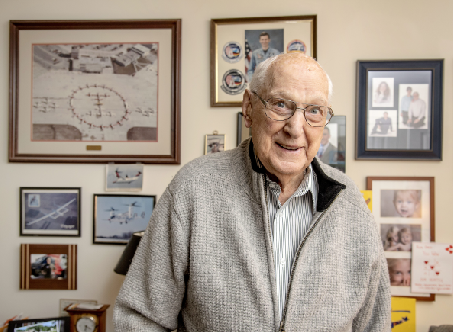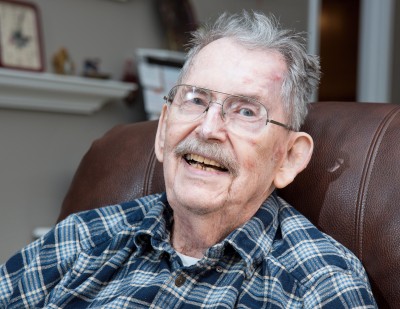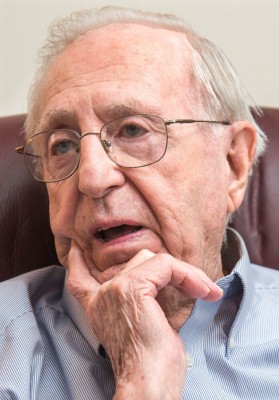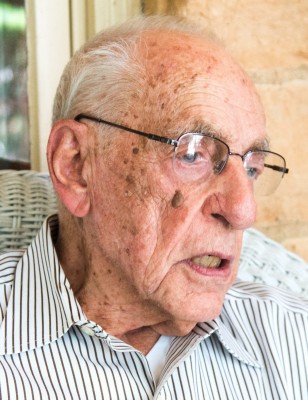Omer Benn
By Paul Wood

Photo By Rick Danzl
CHAMPAIGN — Omer Benn learned how to fly Navy planes during World War II, and then taught for 34 years at the University of Illinois Institute of Aviation.
His grade school in Wisconsin had an unusual neighbor: a prison across the street.
“It made an impression,” he said.
One advantage, he said, was that the prisoners played baseball near the fence and sometimes “knocked a ball over the wall, and we might catch it.”
On Pearl Harbor Day, he was a junior in high school. Barely 17, he entered what is now the University of Wisconsin-Stout in industrial arts.
But the war drew him to enlist in the Navy as an aviator in 1943.
“You’d either come home whole, or not at all,” he said.
His training was extensive and time-consuming.
Ground school was at St. Olaf College in Minnesota. One of his challenges there was meeting a time limit on running a course over hilly ground, sometimes in snow.
Then he was off to Washington State for pilot training in Spokane. He started out on a Luscombe trainer.
It was not a good start for Benn.
“My flight instructor was paranoid,” he said, “And he chewed snuff and spit it into shop towels. I squeaked through when there was a change of instructors.”
In the Navy’s collegiate program, cadets had another school — this time for physical training, at St. Mary’s College of California.
It was a tough program, Benn said. Cadets were told to look at the person on the right and then on the left. “Only one out of three of you will complete the course,” they were told.
Many simply dropped out, he said.
“I was dumb enough to say ‘you can wash me out, but I won’t quit,’” said Benn, who still gets around well at 94.
At Norman, Okla., he trained on Stearman Model 75 “Kaydets,” which were biplanes.
Oklahoma was legislatively a dry state, but that didn’t stop instructors from flying to Texas for whiskey and beer, Benn said.
In Pensacola, Fla., Benn trained on Beechcraft Twins and PBY flying boats. By this time, it was 1945, and the ensign earned his wings.
Ironically, all that training meant he missed the war.
The squadron was sent to Kansas.
“We were headed to the Pacific but never left Hutchison,” he recalled.
Benn had been prepared to go to Japan to fly patrols, an unusually dangerous task. Then two atomic bombs were dropped.
Like many soldiers and veterans, Benn had to figure out what to do next. He wanted to be an aviator, but he didn’t have the flight hours that men sent overseas did, so there were pilot jobs for him.
So he went back to UW-Stout, buckling down on college with men who were a little more mature than college boys. He earned two degrees there.
“I was on the GI Bill, the smartest thing the government ever did,” Benn said.
He taught industrial education for seven years.
Then he got his chance: an offer to be a flight instructor at the UI.
Benn was the flight examiner for 34 years. He also testified at trials after investigations.
In 1968, he authored a book, “Private pilot flight course utilizing the General Aviation Trainer and Simultaneous Instrument Contact Technique.” There’s even an Omer Benn Aviation Scholarship at Parkland, which now runs the aviation program.
On his 90th birthday, he flew one last time, joined by another pilot, and did touch-and-go landings and flew by instruments.
Some 72 years after earning his wings, Benn pinned them on a Coast Guard uniform — his granddaughter’s.
Read more stories from local veterans:
 Fred McCauley
CHAMPAIGN — In September 1952, recent MIT graduate Fred McCauley came to Korea to serve as a forward observer for a mort …
Fred McCauley
CHAMPAIGN — In September 1952, recent MIT graduate Fred McCauley came to Korea to serve as a forward observer for a mort …
 Clyde Hudson
URBANA — On a patrol ship, Clyde Hudson served in both the Atlantic and Pacific hunting submarines that could attack con …
Clyde Hudson
URBANA — On a patrol ship, Clyde Hudson served in both the Atlantic and Pacific hunting submarines that could attack con …
 Richard Cogdal
URBANA — Besides winning medals for serving at sea off Iwo Jima and Okinawa, Richard Cogdal touched history when he had …
Richard Cogdal
URBANA — Besides winning medals for serving at sea off Iwo Jima and Okinawa, Richard Cogdal touched history when he had …